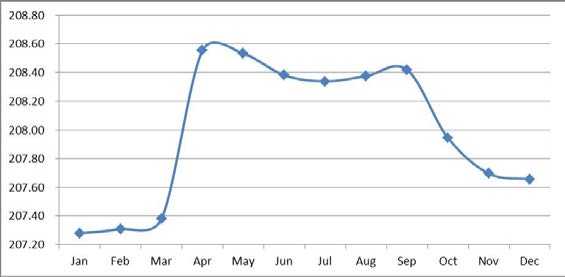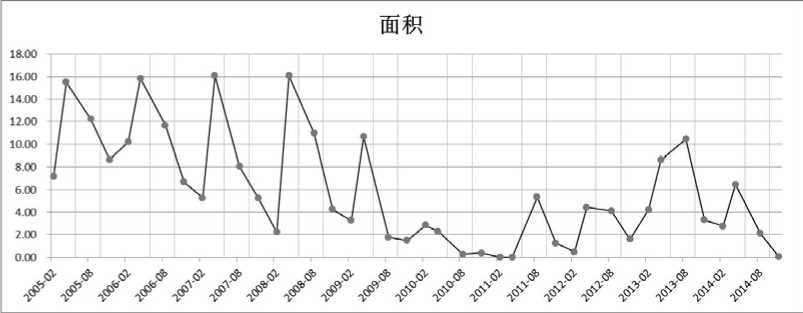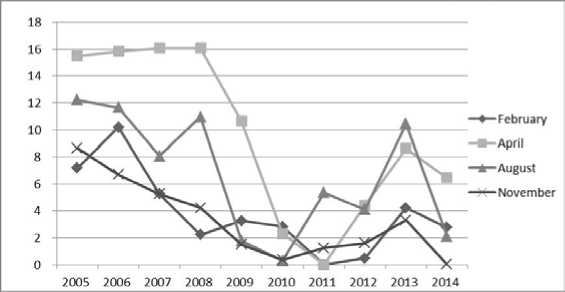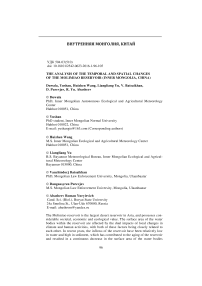The analysis of the temporal and spatial changes of the Molimiao reservoir (Inner Mongolia, China)
Автор: Duwala , Yushan , Huizhen Wang, Liangliang Yu, Batsaikhan V., Purevjav D., Abasheev R.Yu.
Журнал: Природа Внутренней Азии @nature-inner-asia
Рубрика: Внутренняя Монголия, Китай
Статья в выпуске: 1 (1), 2016 года.
Бесплатный доступ
The Molimiao reservoir is the largest desert reservoir in Asia, and possesses considerable societal, economic and ecological value. The surface area of the water bodies within the reservoir are affected by the dual impacts of local changes in climate and human activities, with both of these factors being closely related to each other. In recent years, the inflows of the reservoir have been relatively low in water and high in sediment, which has contributed to the aging of the reservoir and resulted in a continuous decrease in the surface area of the water bodies within the reservoir. Duwala et al. The Analysis of the Temporal and Spatial Changes of the Molimiao Reservoir (Inner Mongolia, China) Against the global backdrop of climate change, it would be beneficial to strengthen the monitoring of the surface area of the reservoir’s water bodies, to further utilize the functional value of the reservoir. In this work, remote sensing, hydrological and meteorological data were used to analyze the temporal and spatial changes of the reservoir. These results show that the surface area of the water bodies within the Molimiao reservoir have decreased over the last 10 years. Highly distinct characteristics were found in the monthly and yearly variations in the surface area of the water bodies, and a strong correlation was found between the water bodies’ surface area and climatic conditions.
Remote sensing, surface area of water bodies, correlation analysis, molimiao reservoir
Короткий адрес: https://sciup.org/148317974
IDR: 148317974 | УДК: 504.03(510) | DOI: 10.18101/2542-0623-2016-1-96-105
Текст научной статьи The analysis of the temporal and spatial changes of the Molimiao reservoir (Inner Mongolia, China)
The Molimiao reservoir is the largest desert reservoir in Asia, and lies within the Horgin Desert of Inner Mongolia, next to the Western Liao River. Floods have historically occurred quite frequently in the Western Liao River plains, with a number of these floods having been recorded since the establishment of China. The main defensive measure against floods in the Western Liao River plains is the storage of flood waters. The runoff of the Western Liao River is highly variable, with flows often becoming cut-off during drought seasons; the degree of assurance of the water supply is consequently quite low [1]. The Molimiao reservoir serves multiple functions, with flood prevention, the supply of water to cities and the irrigation of crops being its most important functions; the reservoir also serves as a base for aquaculture and tourism [2]. The Molimiao reservoir has thus fulfilled the needs of flood prevention for the Western Liao River and economic interests, while also serving an important regulatory role in the ecosystem of the reservoir and its surrounding regions. Therefore, the overall political, societal, economic and ecological value of the Molimiao reservoir is beyond measure, making the initiation of temporal and spatial monitoring of the surface area of the reservoir’s water bodies a matter of extreme importance.
In recent years, a number of highly effective methods have emerged for studies on the monitoring of water bodies using satellite information. The differences between these water body remote sensing methods primarily lie in the treatment methods used to resolve complications caused by the shadows of clouds and mountains, as well as the near-infrared or mid-infrared pixel-level confusions between water bodies and surface constructions [3]. The spectral absorption of water bodies within the visible wavelengths increases with wavelength, while its reflectance decreases with wavelength; as the wavelengths approach the near-infrared and mid-infrared spectral regions, the reflectance of water bodies becomes extremely low and approaches zero. Conversely, the reflectance of land objects such as soil and vegetation has a stronger reflectance in the near-infrared than in the blue [4]. The primary method for recognizing water bodies in remote sensing is to differentiate between water bodies and other objects via the spectral characteristics of water and other objects (i.e. the low reflectance of water in the near-infrared and mid-infrared and the high reflectance of other objects within these spectral regions). Pixels that have detected water bodies may thus be distinguished and separated from groups of mixed pixels.
The extraction of lakes should be as accurate, rapid and automated as possible, as the timely acquisition of remote sensing data, the convenient production of monitoring products and intuitive monitoring results will enable an accurate reflection of the growth and decline of the surface area of the water bodies within the reservoir, the collapse of soil on the shores of the reservoir or islands within the reservoir, and changes such as the bare deposition of sediment within the reservoir, thus providing an effective scientific basis for the dynamic management of the reservoir. The continued development of satellite remote sensing technologies has provided an effective technological measure for monitoring changes in water bodies. Domestic and overseas scholars such as McFeeters, Ouma, XuHanqiu and LuoJiancheng have advanced a number of water body indices that provide the groundwork for accurately extracting signals associated with water bodies and its corresponding changes [5–8]. In this work, high spatial resolution satellite remote sensing data was used to extract the surface area of the water bodies within the Molimiao reservoir, for the monitoring of its characteristic temporal and spatial variations.
2. Materials and Methods 2.1 Overview of the area of study
The Molimiao reservoir was established in 1959, and is located on the left shore of the Western Liao River. The reservoir lies within the rural territory of the Horqin District of Tongliao City, 43km from Tongliao City, and has a total reservoir capacity of 19.2 billion m3. The main sources of supply waters for the reservoir are atmospheric precipitation and water from the upper reaches of the Xiliao River. The water in the reservoir is mainly stored as surface water, groundwater and soil water, which are annually renewed via the water cycle. The upper reaches of the reservoir are mainly streams such as the Laoha River and Xar Moron River. The inflows from each of these rivers have large interannual variations and are strongly seasonal, and are thus random and cyclical in nature. These rivers are located upon plain regions and are highly variable in runoff with large differences between low and high flows; all of these rivers fall within the category of wandering rivers. As the lithology of the plains is dominated by sandy soil, the loss of runoff due to the soil in these rivers is quite significant. The Jiaolai River and Xar Moron River have relatively high levels of sediment, and large interannual variations in sediment discharge which are mainly concentrated in years with high-flow.
2.2 Data and methods
2.2.1 Selection of the monitoring periods
The periods for monitoring of the water bodies’ surface area were selected based on records of the water levels and storage volumes of the Molimiao reservoir from 1994 to 2013. The results indicate that the storage volumes and
2.2.2 Methods for periodical monitoring
This work used the visual interpretation method to extract the surface area of reservoir water bodies, as image classification, threshold segmentation, water body indices and the differences between the spectral characteristics of water bodies within a desert environment and that of other land objects were insufficient to accurately exclude the influence of other land objects on the delineation of lake boundaries. A long-term sequence of remote sensing imaging data of the Molimiao reservoir in February, April, August and November from 2005 to 2014 was obtained from various sources, including Landsat-5 TM, Landsat-8 OLI and environmental satellites. High-accuracy geometric corrections of the remote sensing data were performed using topographic maps, and the extraction of the surface area of the water bodies within the reservoir was performed after pretreatments such as image mosaicking were completed.
3. Results and analysis
3.1 Analysis of the surface area of the water bodies
water levels are always lower in February and November, while being higher in April and August. Based on the map of the multi-year average water level, the water levels tend to be lower from January up to March. The water levels then rise linearly from April and onwards, until it reaches its highest value, after which it decreases in a fluctuating manner, with the decreases from October up to December being more significant. The analysis above indicates that the dry periods are represented by the months of February and November, while April and August represent the wet periods; these were then designated as the monitoring periods for the surface area of the water bodies within the reservoir.

Fig. 1 The average water level of Molimiao reservoir from 1994-2013unit : m
Through the methods described above, the recorded values of the surface area of reservoir’s water bodies during the dry periods of February and November and the wet periods of April and August from 2005 to 2014 were ob- tained (see Table). These results show that the variation in the surface area of the reservoir’s water bodies during the wet period in April is significant. The reservoir’s surface area was maintained at 10 km2 and above prior to 2009 and was at its highest in 2008, reaching an area of 16.08 km2; the reservoir then started to decline in 2010, and nearly dried up in 2011. The reservoir recovered somewhat from 2012 up to 2014, but the surface area of the reservoir’s water bodies only reached 6.47 km2 in 2014, a far cry from its previous water levels. Large fluctuations were observed in the surface area of the water bodies in August. As for the surface area of the reservoir’s water bodies during the dry period in February, it was observed that the largest surface area was reached in 2006 at 10.20 km2, and the reservoir nearly dried up in 2011. The surface area of the water bodies in November decreased from 2005 to 2010, with the reservoir nearly drying up in 2010, as its surface area was only 0.37 km2 in that year; the water bodies’ surface area recovered somewhat in the next few years, but the reservoir remains close to a dry state.
Table
The water area of reservoir in the last 10 years ( 2005–2014 ) unit : km2
|
Febr |
Apri |
Aug |
Nove |
|
|
1984 |
21.6 |
|||
|
2005 |
7.18 |
15.5 |
12.2 |
8.64 |
|
2006 |
10.2 |
15.8 |
11.6 |
6.71 |
|
2007 |
5.26 |
16.0 |
8.06 |
5.26 |
|
2008 |
2.23 |
16.0 |
10.9 |
4.24 |
|
2009 |
3.27 |
10.6 |
1.78 |
1.50 |
|
2010 |
2.83 |
2.30 |
0.28 |
0.37 |
|
2011 |
drie |
drie |
5.36 |
1.25 |
|
2012 |
0.48 |
4.42 |
4.11 |
1.60 |
|
2013 |
4.23 |
8.62 |
10.4 |
3.31 |
|
2014 |
2.77 |
6.47 |
2.10 |
0.02 |
Figure 2 reflects on the trajectory of the changes in the surface area of the Molimiao reservoir’s water bodies over the last 10 years. As a whole, the surface area of the reservoir’s water bodies has shown a downwards trend from 2005 up to 2014, with the surface area reaching its lowest point in 2010, as the surface area of the water bodies was close to 0 from the dry months of February up to the wet period in August. The surface area has increased gradually since August in 2011, with the wet period in August 2013 reaching a surface area of approximately 10 km2.

Fig. 2. The surface area of the water bodies within reservoir in the last 10 years (2005–2014) unit : km2
3.2 Analysis of special cases within the monitoring period
During the time period in which the surface areas of the water bodies were monitored, the reservoir showed signs of drought during the period from 2009 up to 2012. The reservoir monitoring map reflected on the location of the reservoir, its surrounding environment, the surface area of water bodies within the reservoir and the surface distribution of water, with these being directly observable monitoring results. The comparative chart of water surfaces was then created by superimposing water surface boundary lines (from 1984) as a reference on the reservoir monitoring map; the resulting chart shows areas of the reservoir that have receded, and areas that have been newly flooded by the reservoir, which facilitates a clear and intuitive view of the reservoir’s water surfaces before and after changes have occurred.
3.3 Regression analysis of the surface area of water bodies during summer and climatic conditions
4. Discussions and Conclusions
4.1 Characteristics of the monthly variations4.2 Characteristics of the yearly variations
Figures 3 indicate that the surface area of the water bodies within the reservoir zone shows a downwards trend from 2005 up to 2011. The magnitude of the decrease was at its greatest from 2009 to 2010, to the extent that the reservoir had dried out in 2011, while the reservoir was nearly dry throughout 2010. This has weakened the capacity of the Molimiao reservoir to regulate and store floodwaters.
4.3 A strong correlation was found between the water bodies’ surface area and climatic conditions

Fig. 3.The surface area of the water bodies within reservoir in the last 10 years (2005–2014) unit : km2
A statistical linear regression analysis was performed on the surface area of the Molimiao reservoir’s water bodies, rainfall, and the daily hours of sunshine during the summer months. The relationship between these quantities is given below:
S=46.944+0.019p-0.054n (1)
In this equation, S is the surface area of the water bodies in the Molimiao reservoir in August, in units of km2; p is the average summer precipitation in the upper reaches of the Molimiao reservoir within the same period, in units of mm; n is the average daily hours of sunshine during summer recorded at the automated stations on the shores of the Molimiao reservoir during the same period, in units of h. From this equation, it is shown that if no change has occurred in the summer precipitation of the upper reaches of the reservoir, the surface area of the lake regions then decrease with increasing hours of sunshine on the shores of the reservoir. This indicates that the longer hours of sunshine during summer increases the rate of water evaporation from lakes, thus shrinking the surface area of the lake zones.
The monthly variations of the surface area of the Molimiao reservoir’s water bodies abide by a cyclical and persistent pattern. Over the 10 years from 2005 to 2014, the surface area of the reservoir’s water bodies were low in February and November, as these are the dry periods; the surface area of the water bodies was higher in April and August, as these are the wet periods. The surface area is at its highest in April. The ratio of the water bodies’ surface area during the wet periods to the surface area during the dry periods varies between 0.8 and 4.2. This characteristic is consistent with actual monitoring results, and this forms a characteristic annual cycle that is compatible with the seasonal climate.
There is a strong correlation between the surface area of the Molimiao water bodies and the average summer precipitation in the upper reaches of the reservoir and the average hours of daily sunshine on its shores. August in particular, sees a large increase in precipitation, and a corresponding increase in the surface area of the reservoir’s water bodies. As the daily hours of sunshine increase, the surface area of the reservoir’s water bodies then decrease in tow.
-
4.4 Analysis of the relationship between the surface area of water bodies and water levels
The surface area of the water bodies in the Molimiao reservoir have decreased year by year since 2005, despite the water level during this period not changing significantly and increasing in certain years. This is due to the large amounts of sediment in the upstream river flows that deposit large amounts of sediment in the reservoir, causing the underlying surface of the reservoir to increase continuously. This is an indirect indication of the reservoir’s aging; further reinforcement of the reservoir and dredging work are thus necessary as a result.
The changes in the surface area of the Molimiao reservoir’s water bodies are a result of the dual impacts of climate change and human activities, with these two factors being closely linked to each other. The reservoir not only provides socio-economic benefits for the region, but also has ecological value in improving the region’s climatic environment. Changes in the ecological environment of the reservoir zone will conversely have socio-economic impacts on the region. Against the global backdrop of climate change, the key to enhancing the functional value of the reservoir zone is the strengthening of resource management in the reservoir zone and its upper reaches. Due to limitations in the current available data, a deeper analysis has yet to be performed in this work; the next step in should focus on combining socio-economic, climatic, and quantitative water irrigation data of the basin, to enable a quantitative calculation and analysis of the influence of climate change and human activities on changes in the surface area of the water bodies in the reservoir zone.
Acknowledgements
This study was supported by National Natural Science Foundation of China (No. 41461102), and Science and technology plan projects in Inner Mongolia multi-scale Mongolia plateau grassland fire risk comprehensive evaluation technology research based on 3S (No. 201502113), and Arxan forest disasters monitoring and early warning and emergency management system research .
Список литературы The analysis of the temporal and spatial changes of the Molimiao reservoir (Inner Mongolia, China)
- Wang Zhi-yong, Jiang Hui-ling, Wu Shu. The Necessity and Feasibility of the Construction of the Reservoir Molimiao Urban Water Supply Project [J]. Inner Mongolia Water Resources. 2004. No. 2. Pp. 104-105
- Baoyinjirgal Jigemid. Survey on Birds in Molimiao Reservoir Adjacent Region in Tongliao [J]. Journal of Inner Mongolia University for Nationalities (Natural Sciences). 2006. No. 21(6). Pp. 656-658
- Tian Yu, Lin Zong-jian, Lu Xiu-shan, Liang Yong, Qiao Ping-lin. Application of the Method of Extraction of Reservoir Surface Area based on GIS and Remote Sensing. Water Resources Protection. 2008. No. 24(2). Pp. 30-33
- Qu Wei, Lu Jing-Xuan, Li Lin, Li Xiao-Wen. Research on Automatic Extraction of Water Bodies and Wetlands on HJ Satellite CCD Images. Remote Sensing Information. 2011. No. 4. Pp. 28-33
- McFeeters Sk. The Use of Normalized Difference Water Index (NDWI) in the Delineation of Open Water Features. International Journal of Remote Sensing. 1996. No. 17(7). Pp. 1425-1432
- Ouma Y.O., Tateishi R. Lake Water Body Mapping with Multi-Resolution based Image Analysis from Medium-Resolution Satellite Imagery. International Journal of Environmental Studies. 2007. No. 64(3). Pp. 357-379
- Xu Han-qiu. A Study on information extraction of water body with the modified normalized difference water index (MNDWI). Journal of Remote Sensing. 2005. No. 9(5). Pp. 589-595
- Luo Jian-cheng, Sheng Yong-Wei, Shen Zhan-Feng et al. Stepwise Iteration Mul-tispectral High-Precision Automatic Extraction of Water Body Information. Journal of Remote Sensing. 2009. No. 13(4). Pp. 610-615


